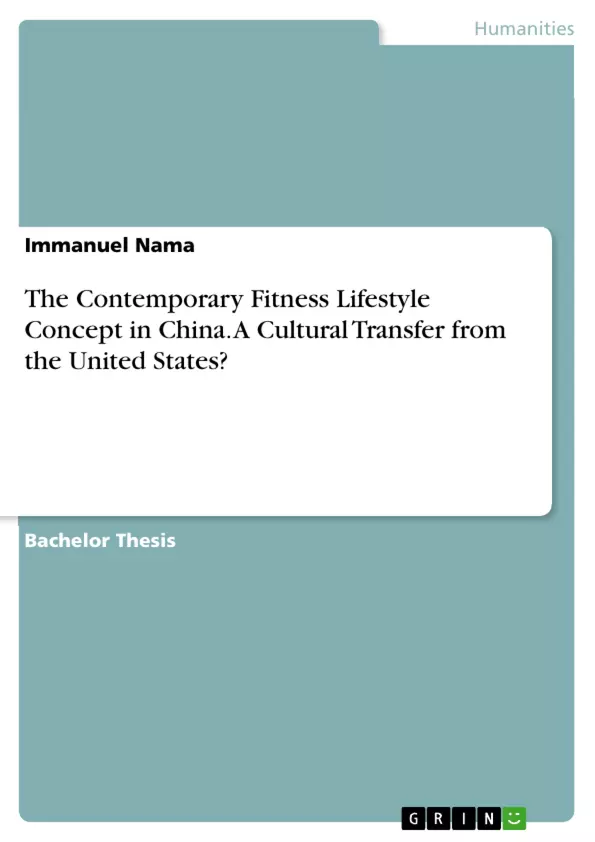This paper is focused on the cultural transfer of contemporary American fitness culture into the Chinese environment. In what respect does the current state of the contemporary Chinese fitness culture reflect this process? Furthermore, cultural implications will be analyzed as well as the question about the shape of the cultural transfer is going to be answered: What part of the transfer is “literally” adopted from the United States, what parts of the culture are reinterpreted, what is distinctly Chinese?
To achieve this rather ambitious goal in this fairly limited scope, it is going to be explored what makes the fitness lifestyle as culture unambiguously American by looking at its historical roots and cultural features, before a snapshot of the adaption on Chinese soil including the determining cultural idiosyncrasies will be analyzed in depth. As the thesis is working with the framework of cultural transfer as well as it is exploring a concept of lifestyle, these two concepts will be initially defined to clarify what is going to be discussed subsequently.
Inhaltsverzeichnis (Table of Contents)
- 1. Introduction
- 2. Definitions and Framework
- 2.1. The Framework: Cultural Transfer
- 2.2. Lifestyle - A Definition
- 3. The Contemporary American Fitness Culture
- 4. Analysis of the Contemporary Chinese Fitness Culture
- 4.1. Life Chances and Life Choices: Who is participating in the culture?
- 4.2. The Motives for Fitness in China: Why are people participating?
- 4.3. Fitness in Practice: How is fitness carried out in China?
- 4.4. Approaching Fitness in China from a Political Point of View
- 4.5. The Chinese Cultural Concept of Contemporary Fitness Culture
- 5. Conclusion – A Cultural Transfer (?)\n
Zielsetzung und Themenschwerpunkte (Objectives and Key Themes)
This paper analyzes the cultural transfer of contemporary American fitness culture into the Chinese environment, examining how the current state of contemporary Chinese fitness culture reflects this process. It delves into the cultural implications and seeks to understand the nature of the cultural transfer: what elements are "literally" adopted from the United States, what parts are reinterpreted, and what elements are distinctly Chinese. The paper investigates the historical roots and cultural features of American fitness culture, and analyzes the adaptation of these features on Chinese soil, including the determining cultural idiosyncrasies.
- Cultural transfer of contemporary American fitness culture to China
- Cultural implications of the transfer process
- Adaptation and reinterpretation of American fitness culture in China
- The role of cultural idiosyncrasies in shaping the Chinese fitness landscape
- The impact of political and social factors on fitness participation
Zusammenfassung der Kapitel (Chapter Summaries)
The introduction sets the stage for the paper, describing the author's initial observations of a fitness facility in China and drawing parallels with the broader context of sports and fitness in China and the United States. The chapter examines the rise of fitness culture in China, contrasting it with the perception of fitness practices in the United States. It highlights the growing popularity of fitness in China and the cultural transfer process that it is undergoing.
Chapter 2 defines the key concept of cultural transfer, outlining its framework and exploring the concept of lifestyle. The chapter emphasizes the dynamic nature of cultural exchange in a globalized world and examines the different stages of adoption, from willing integration to resistance.
Chapter 3 provides an overview of the contemporary American fitness culture, exploring its historical roots and cultural features. This chapter lays the foundation for understanding the origins of the fitness lifestyle as it is being transferred to China.
Chapter 4 focuses on the analysis of the contemporary Chinese fitness culture, exploring its characteristics and comparing them with the American counterpart. It examines the demographics of fitness participants in China, the motivations behind their engagement, and the practical aspects of fitness practices. The chapter also addresses the political and social factors that influence fitness in China.
Schlüsselwörter (Keywords)
The key concepts and terms explored in this paper include cultural transfer, contemporary fitness culture, American fitness culture, Chinese fitness culture, cultural adaptation, cultural idiosyncrasies, lifestyle, life chances, life choices, motivations, practices, political influences, and social factors.
- Quote paper
- Immanuel Nama (Author), 2016, The Contemporary Fitness Lifestyle Concept in China. A Cultural Transfer from the United States?, Munich, GRIN Verlag, https://www.grin.com/document/378818



